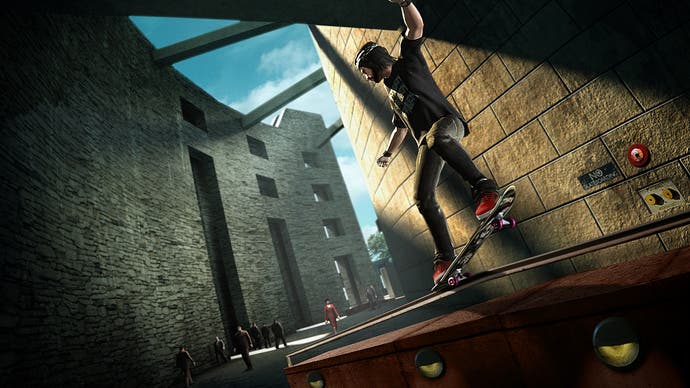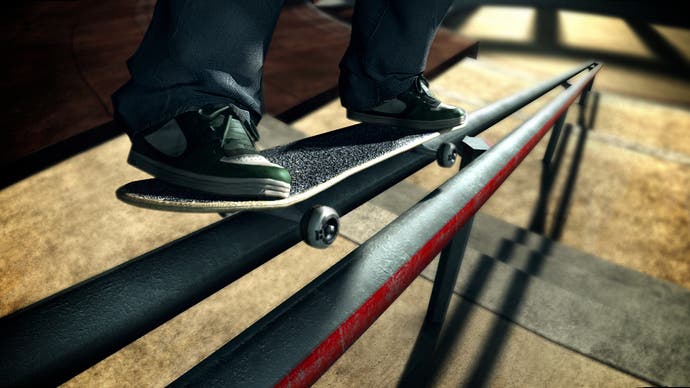SKATE
Eyes on the Hawk.
There's no skirting around the issue here. As jetlagged producer Jay Balmer demos Skate to us and talks us through it, he compares absolutely every part to the Tony Hawk series. It'd be impossible to get around the fact that it's their competition and we're grateful he doesn't try. So are Mr. Hawk's days numbered? After a good play of the latest build, if it hadn't been for Project 8 pulling the licence back from its sharp nosedive we'd have to say yes.
Skate's aiming to give us a slick simulation, and the realism Black Box is going for is evident the second you see the game moving. Your character's weighty animations are viewed from behind a very slight fisheye lens that trails behind you low to the ground in the style of skating videos, and bits of your minimalist HUD only ever pop up after a trick or if you're near a challenge.
Another thing you'll quickly notice is Skate's city (nicknamed ‘San Bancouver') is a mix of San Francisco's hills and traffic, Barcelona's wide open plazas and Vancouver, where Black Box is based and do its real-life skating. But what's interesting is it is not making a Skater's utopia of lethal gaps, endless grinds and inexplicable half pipes. It is making a city. There are skate parks, sure, but once you leave them tricking gets harder and in theory more rewarding as you have to keep your eyes peeled for suitable spots.

Balmer also eagerly explains they're trying to help immerse you by making the world ‘reactive', using the specific and slightly disturbing example that if you plough into a granny at top speed she might not do anything, but that jock across the street who sees you might. They also want skater types around the city to start recognising you as you inevitably turn from nobody to pro skater. It all makes Project 8 sound... well, not bad, but a little silly.
But the real big deal is, as we'd hope, how the game plays. Controls are a fair bit simpler than Project 8, with what felt like a little more depth. The face buttons let you push off with either foot, or brake. The left thumbstick controls which way you're leaning, and the right thumbstick is your board control. The left and right triggers cause you to grab your board with your left and right hands. And... that's it. All of this is second nature within half an hour of picking up the pad, and just like skating for real the tricky part is figuring out what tricks you can do with the limited moves at your disposal.
Pull the board control stick towards you, you sink down toward your board. Ease the stick back up slowly and find the sweet spot to balance on, you'll start a manual. Snap the stick back up to the middle, you'll ollie. Snap it back up to the middle with a slight lean to the left or right, the board gets sent spinning round in that direction as you ollie- you've just done a kickflip. Grinding? The only rule is to physically get your board against that rail, and the type of grind you do depends on how you're leaning and angling your board when you land. Your custom character doesn't gain stats or moves as you play- everything's in there from the start and it's you who has to master your board. If you want to get more air on half pipes, head over to them and work on the timing of your crouching.

Up and coming UK skater and avid Tony Hawk game fan Lucien Clarke was at the Skate event, and after he had a chance to play it we asked him how he felt. "It's great, it's just a little bit more real than Tony Hawk." he beams. "It's just like skating but with my thumbs. If I want to turn, I lean my body. If I want to ollie I come down, then up."
A side effect of the controls is an unending feeling of growth and discovery. After a few dozen virtual skinned knees and broken wrists we were getting confident, which made us a little more adventurous, which made us try leaning back after an ollie. Our character's board shot off over the wall of the skate park and after a glorious airborne second he landed flat on his back. Overhearing someone from EA stifling giggles we asked them whether you could use that move for anything. "Of course," they told us. "You can do flips if you have enough air and remember to grab hold of your board." It was like a supernatural being opened up our brains and put an objective list in there. (1) Land a backflip. (2) Squeal uncontrollably while high-fiving everybody nearby.
One thing that does unlock as you get better known in Skate is areas, but even this has a neat little twist. You can play nice and clean, getting your name in lights by impressing the pros scattered around town, working with cameramen and winning competitions, or you can dabble in something a little darker. Skate's going to feature skate-free areas you can get kudos for tricking in if you don't get caught by security guards, or you can enter into deadly downhill races and experience the game's awesome simulated speed wobble.

Skate's other big feature is its footage editing. At any point you can stop the game, watch the last few minutes of play from a number of angles at whatever speed you want (complete with slowed, lower pitched audio) and then export the video either to your console or Skate's website. Black Box are thinking friends'll enjoy meeting up online, skating together for a few hours and then watching and trading their footage. It does sound pretty appealing.
Even if Skate doesn't quite manage to pilfer Hawk's crown we're looking forward to it for the chance to start from scratch as a skater again. As incredible as Project 8 was, anyone who'd avidly played a Tony Hawk game before was missing out on a lot of the challenge, and so some of the appeal. Plus, we never came close to landing a backflip.
Skate will be released on PlayStation 3 and Xbox 360 later this year from EA.



.png?width=291&height=164&fit=crop&quality=80&format=jpg&auto=webp)




.jpg?width=291&height=164&fit=crop&quality=80&format=jpg&auto=webp)
